You may have already noticed that the english part of “Hefe und mehr” is quite at the moment. And I’m afraid that it will stay like this for longer. We had rough times in the last months, with both sad losses and exiting news. Both consume a part of the energy I invest in the blog. And so I decided to step down for now and focus on the german part – as this language is my native language and writing comes more easily to me. I hope I can add the translations when we reach calmer water again. In the meantime please use google translator to read the newest posts.
Lussekatter
![Lussekatter (2)[3] Lussekatter (2)[3]](https://www.hefe-und-mehr.de/wp-content/uploads/2019/12/Lussekatter-23.jpg) It’s been a long time, since I published my first Lussekatter recipe. Back then I learned that in Sweden you can find two different types of recipes: one with quark, and one without. The variant with quark was on my to do list ever since. And I had a recipe draft ready already three years ago. But an ugly flu stopped me baking back than and two Saint Lucia Days passed without me baking Lussekatter. But this year, finally, I managed it!
It’s been a long time, since I published my first Lussekatter recipe. Back then I learned that in Sweden you can find two different types of recipes: one with quark, and one without. The variant with quark was on my to do list ever since. And I had a recipe draft ready already three years ago. But an ugly flu stopped me baking back than and two Saint Lucia Days passed without me baking Lussekatter. But this year, finally, I managed it!
The Lussekatter with Quark are delicious. A hint of cardamom rounds the flavour but stays in the background while saffron is the main flavour component. Like my favourite Zopf-Recipe I replace part of the butter with cream, so the dough or the formed rolls can rise in the fridge, too.
Malty Bread with Seeds
![Malziges Saaten-Mischbrot (1)[3] Malziges Saaten-Mischbrot (1)[3]](https://www.hefe-und-mehr.de/wp-content/uploads/2019/12/Malziges-Saaten-Mischbrot-13_thumb.jpg) This is a typical blogger problem during the winter months: the daylight vanishes at the same time I pull a bread from the oven. If the day was bright enough for nice pictures anyway. The problem can be easily solved with a foto lamp. But with a broken bulb, my studio lamp was as useful for nice pictures as a coat hanger. And so I put one loaf in the freezer and ordered a new LED bulb. Until it was delivered, the weather cleared, too and I was finally able to take a nice picture with daylight.
This is a typical blogger problem during the winter months: the daylight vanishes at the same time I pull a bread from the oven. If the day was bright enough for nice pictures anyway. The problem can be easily solved with a foto lamp. But with a broken bulb, my studio lamp was as useful for nice pictures as a coat hanger. And so I put one loaf in the freezer and ordered a new LED bulb. Until it was delivered, the weather cleared, too and I was finally able to take a nice picture with daylight.
And I’m very happy, as I like this bread very much. It is a perfect every day bread for lovers of sunflower and pumpkin seeds. Continue reading
Pameln
![Pameln (1)[7] Pameln (1)[7]](https://www.hefe-und-mehr.de/wp-content/uploads/2019/11/Pameln-17_thumb.jpg) The second recipe for rolls from East-Germany which I found in an old Baking book from 1930 is a recipe for “Pameln”. The recipe itself was once again rather short: Use a waterdough with some rye flour mixed in. But at least the description for forming was better this time: Roll the dough into a shape similar like Berliner Schrippen and cut it length wise prior to baking.
The second recipe for rolls from East-Germany which I found in an old Baking book from 1930 is a recipe for “Pameln”. The recipe itself was once again rather short: Use a waterdough with some rye flour mixed in. But at least the description for forming was better this time: Roll the dough into a shape similar like Berliner Schrippen and cut it length wise prior to baking.
I try to research about this kind of rolls like I did it for the Salzkuchen, but I only found some posts of people looking for a recipe. And so here it is, my try on an Pameln. It is a delious roll with a soft crumb and complex flavour due to the sourdough!
Campingwecken
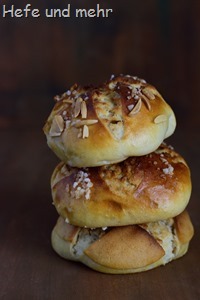 A dear reader told me last year about a speciality in the north-western Part of germany: Campingwecken (lit. Camping rolls). She descripted it as a roll filled with a mixture of roasted almonds and pearl sugar. I was intrigued and started researching. It seemed, that the variant with almond is a rare one, more commenly is a variant with only pearl sugar. I even found a bakery who offered this kind of rolls in the city of Leer in our last vacation in East Frisia, so I could try this roll.
A dear reader told me last year about a speciality in the north-western Part of germany: Campingwecken (lit. Camping rolls). She descripted it as a roll filled with a mixture of roasted almonds and pearl sugar. I was intrigued and started researching. It seemed, that the variant with almond is a rare one, more commenly is a variant with only pearl sugar. I even found a bakery who offered this kind of rolls in the city of Leer in our last vacation in East Frisia, so I could try this roll.
But as I I’m a curios person, I wanted to eat the almond version as well. And so today I have now Campingwecken in both variants for you!
Stollen Baking 2019
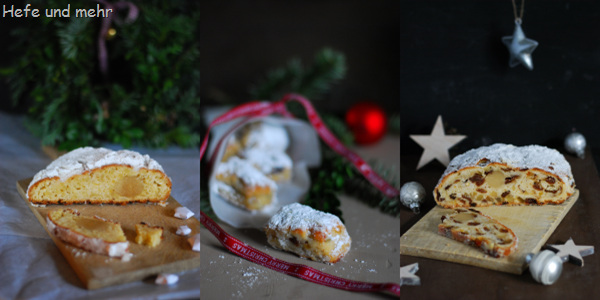
Like every year I don’t have to check the calendar to know that it is nearly November. A short glance in my blog statistic shows me that from day to day the click number for my Stollen recipe rise strongly. And I knew that you – just like me – started to plan baking stollen now. And while since years I’m happily baking my favourite moist Christstollen I posted some recipe variants in the last years, too. To give you a guide to recipes and tips is here a overview where you can find it: Continue reading
Pommerscher Salzkuchen
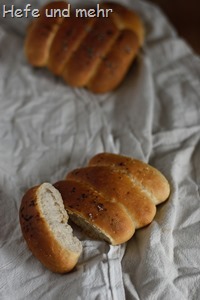 Since I started to collect regional bread recipes from Germany, I struggle with finding recipe from East-Germany. And so I was so happy, when I stumbled about some recipes in an old Diamalt book from 1939. But to be honest, the term “recipe” is very optimistic for the short description in the book. The dough for the Salzkuchen is described as a “Waterdough” and its form as (and this a orignal quote, too!) as “oooo”.
Since I started to collect regional bread recipes from Germany, I struggle with finding recipe from East-Germany. And so I was so happy, when I stumbled about some recipes in an old Diamalt book from 1939. But to be honest, the term “recipe” is very optimistic for the short description in the book. The dough for the Salzkuchen is described as a “Waterdough” and its form as (and this a orignal quote, too!) as “oooo”.
That left me with some question marks in my head. But after some more research I found some other descriptions and pictures of “orginale Salzkuchen”. And with this in Hand I was able to create my recipe.
Kneppkuchen
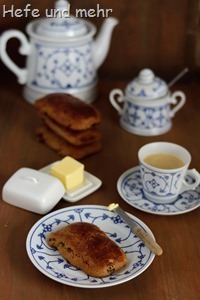 Is there still someone who is surprised about another traditional sweet bread recipe with rye? The longer I collect the regional recipes, the more sweet recipes with rye flour, raisins and sometimes spices I found. Personally I am only wondering about the fact that these kind of breads somehow did not appear in modern baking.
Is there still someone who is surprised about another traditional sweet bread recipe with rye? The longer I collect the regional recipes, the more sweet recipes with rye flour, raisins and sometimes spices I found. Personally I am only wondering about the fact that these kind of breads somehow did not appear in modern baking.
Todays rolls fit in perfectly in the row of Krintstuut, Onjeschwedde, Berchtesgardener Stuck, Kleenroggen and Westerwälder Neujährchen. The Kneppkuchen is a recipe somewhere between a lean cake and a very rich roll. It is made with rye (of course), raisins, anise seeds and cardamom. Originally the dough is prepared with lard, but for vegetarians and vegans it can be baked with coconut oil instead, too.
In my version, you can find a sourdough for a deeper flavour as well as the fact, that the high amount of fat is mixed to short crust dough before being added to to the dough. This little trick makes kneading in the fat much easier.
When serving you do not need anything but a bit of butter, as their flavour is so deep and rich!
Mangbrot
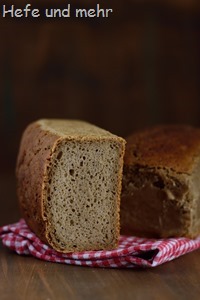
The Mangbrot was a favourite of my grandfather. It is a bread with a long tradition in this corner of germany. The idiom term “Mang” means “Mixed” and referred to the fact that the bread is baked with a mixture of rye and wheat flour. Here, like in other region with cold climate and loamy soil, rye and wheat was planted as mixture. So in good years, the mixture contained more wheat, while in bad years the robust rye prevailed the mixture. I considered this fact and prepared already the sourdough with a mixture of rye and wheat flour. This makes the sourdough a bit milder.
Swedish Blackbread with Coffee
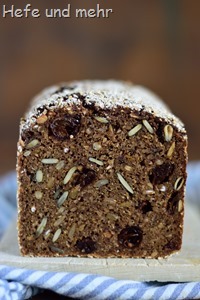
In one of my baking course a participant told me about a bread with coffee she ate in Sweden this summer. The idea of swedish breads with coffee are not strange for me. In a Swedish blog I like Sara from Sara Bakar bake already one or two breads with coffee. But I got hooked only now. And so I created a coffee blackbread based on my familiy’s favourite blackbread. And I have to say, the resulting bread was mindblowing! My dearest, who normally never touch a bread with dried fruits, eats so much of it, that one loaf vanished in a blink.
But one could tell what my secret ingredients was. The coffee adds a incredible round flavour with its roasted notes but is barely recognizable. The amount of molasse is moderate so it is well balanced between sour and sweet. And so the bread is great with Cheese – especially with a young goat cheese. But honey or purists version with only fresh butter is dream as well!
